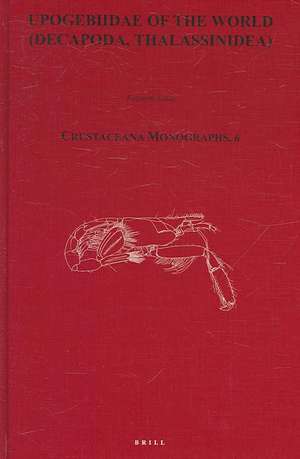Upogebiidae of the World (Decapoda, Thalassinidea): Crustaceana Monographs, cartea 6
Autor Katsushi Sakaien Limba Engleză Hardback – 12 oct 2006
The status of the various taxa recognized is placed in the broader context of a re-evaluation of the contents of the infraorder Thalassinidea.
The contents of the book are not only of interest for systematists but also for ecologists and environmental biologists focusing on neritic and benthic biocoenoses, as these mud shrimps are important agents in bioturbation processes of the sea floor.
Din seria Crustaceana Monographs
- 18%
 Preț: 560.35 lei
Preț: 560.35 lei - 18%
 Preț: 882.64 lei
Preț: 882.64 lei - 18%
 Preț: 941.79 lei
Preț: 941.79 lei - 18%
 Preț: 586.99 lei
Preț: 586.99 lei - 18%
 Preț: 1206.35 lei
Preț: 1206.35 lei - 18%
 Preț: 1275.29 lei
Preț: 1275.29 lei - 18%
 Preț: 1011.30 lei
Preț: 1011.30 lei - 18%
 Preț: 1072.60 lei
Preț: 1072.60 lei - 18%
 Preț: 902.06 lei
Preț: 902.06 lei - 18%
 Preț: 922.38 lei
Preț: 922.38 lei - 18%
 Preț: 734.22 lei
Preț: 734.22 lei - 18%
 Preț: 636.54 lei
Preț: 636.54 lei - 15%
 Preț: 491.82 lei
Preț: 491.82 lei - 18%
 Preț: 996.02 lei
Preț: 996.02 lei - 18%
 Preț: 684.57 lei
Preț: 684.57 lei - 18%
 Preț: 684.57 lei
Preț: 684.57 lei - 18%
 Preț: 733.59 lei
Preț: 733.59 lei - 18%
 Preț: 701.83 lei
Preț: 701.83 lei - 18%
 Preț: 704.01 lei
Preț: 704.01 lei - 18%
 Preț: 1156.96 lei
Preț: 1156.96 lei - 18%
 Preț: 1031.50 lei
Preț: 1031.50 lei - 18%
 Preț: 869.81 lei
Preț: 869.81 lei
Preț: 699.33 lei
Preț vechi: 852.84 lei
-18% Nou
Puncte Express: 1049
Preț estimativ în valută:
133.82€ • 140.00$ • 111.16£
133.82€ • 140.00$ • 111.16£
Carte indisponibilă temporar
Doresc să fiu notificat când acest titlu va fi disponibil:
Se trimite...
Preluare comenzi: 021 569.72.76
Specificații
ISBN-13: 9789004151505
ISBN-10: 9004151508
Pagini: 185
Dimensiuni: 155 x 235 x 16 mm
Greutate: 0.46 kg
Editura: Brill
Colecția Brill
Seria Crustaceana Monographs
ISBN-10: 9004151508
Pagini: 185
Dimensiuni: 155 x 235 x 16 mm
Greutate: 0.46 kg
Editura: Brill
Colecția Brill
Seria Crustaceana Monographs
Public țintă
All those interested in the habitats, as used as the fish baits commercially; they are usually found in muddy flats, or in the sand stones, the sponge or the corals.Notă biografică
Katsushi Sakai, Ph.D. (1965) in Zoology, University of Kyusyu, is emeritus Professor of Shikoku University at Tokushima, Japan. He has published extensively on the classification of Thalassinids, and compiled the Crabs of Japan for the ETI, the world Biodiversity Database (2004).
